Numerical Studies on the Action Mechanism of Combustion Intermediates and Free Radicals on Nitrogen Oxides under Oil-Water Blended Conditions
Abstract
:Featured Application
Abstract
1. Introduction
2. Experimental Method and Experimental Setup
2.1. Experimental Method
2.2. Experimental Setup
3. Results and Discussion
3.1. Two Stages Reaction Processes
3.2. Intermediate Reaction Products (Small Molecules and Free Radicals) at Different WOMR
3.3. Coupling Analysis at Water Mixing and Variable Excess Air Coefficient Conditions
3.3.1. Correlation Analysis
3.3.2. Sensitivity Analysis
4. Conclusions
- An obvious result of two stages reaction processes is obtained by the numerical method. When the temperature reaches to 1000 K, the temperature rises sharply, and the mixture enters the high temperature oxidation stage. The rapid consumption of H2O2 and the rapid generation of OH indicates the generation of the flame surface.
- With the increase of water mass fraction, the response of the reaction of free radicals (H, O, OH, HO2, H2, H2O2) is lagged behind, meanwhile the peak value of the reaction rate decreases due to the increase of heat needed for activation reaction at the same activation energy and reaction temperature. When the water content increases 10%, the maximum generation rate of NO, N2O, NO2 decreases by 15.24%, 9.21%, 14.78% on average, respectively.
- According to the correlation results, maximum production rate of NO and the mole fraction of O, OH, H2 have significant correlation relation; maximum production rate of N2O and the mole fraction of O, OH, HO2, H2 have significant correlation relation; maximum production rate of NO2 and the mole fraction of O, OH, HO2, H2, H2O2 have significant correlation relation. In contrast, OH, O and H2 play a more significant role in the common influence of the generation of nitrogen oxides.
- According to the sensitivity results, elementary reactions #1 and #16 promote the generation of OH and O at the beginning of the second stage, but elementary reaction #9, #13 and #20 have a negative effect. Meanwhile the result is just opposite for effect of HO2 and H2.
Supplementary Materials
Acknowledgments
Author Contributions
Conflicts of Interest
Nomenclature
| H | hydrogen atom |
| O | oxygen atom |
| OH | hydroxyl radical |
| HO2 | hydroperoxyl radical |
| H2 | hydrogen |
| H2O2 | hydrogen peroxide |
| M | third body |
| NOx | nitrogen oxides |
| NO | nitric oxide |
| NO2 | nitrogen dioxide |
| N2O | nitrous oxide |
| EGR | exhaust gas recirculation |
| PM | particle matter |
| CO | carbon monoxide |
| CO2 | carbon dioxide |
| HC | hydrocarbon |
| CA | crank angle |
| PLIF | planar-laser-induced fluorescence |
| LIF | laser-induced fluorescence |
| LLNL | Lawrence Livermore National Laboratory |
| RCM | rapid compression machine |
| GRI | The Gas Research Institute |
| C6H5CH3 | methylbenzene |
| iC5H12 | isopentane |
| iC8H18 | isooctane |
| nC5H12 | n-pentane |
| nC7H16 | n-heptane |
| O2 | oxygen |
| N2 | nitrogen |
| Ar | argon |
| λ | excess air coefficient |
| WOMR | water-oil mass ratio |
| PPMCC | Pearson product-moment correlation coefficient |
| SRCC | Spearman rank correlation coefficient |
| Symbols | |
| specific heat capacity at constant pressure | |
| enthalpy | |
| entropy | |
| the specific heat capacity at constant volume | |
| internal energy | |
| Gibbs free energy | |
| constant column | |
| water-oil mass ratio | |
| mass of water | |
| mass of oil | |
| (X, Y) | two dimension random variables |
| (x, y) | sample of (X, Y) |
| rank of | |
| the mean value of | |
| the mean value of | |
| rs | Spearman rank correlation coefficient |
| t | index of the significance test |
| confidence level | |
| n-dimensional vector of the concentration | |
| the parameter of the system, which is related to the chemical reaction rate, the activation energy and so on | |
| the sensitivity of the component i to the reaction rate of the elementary reaction j |
References
- Subramanian, K.A. A comparison of water–diesel emulsion and timed injection of water into the intake manifold of a diesel engine for simultaneous control of NO and smoke emissions. Energy Convers. Manag. 2011, 52, 849–857. [Google Scholar] [CrossRef]
- Awad, O.I.; Mamat, R.; Ibrahim, T.K.; Ali, O.M.; Kadirgama, K.; Leman, A.M. Performance and combustion characteristics of an SI engine fueled with fusel oil-gasoline at different water content. Appl. Thermal Eng. 2017, 123, 1374–1385. [Google Scholar] [CrossRef]
- Elsanusi, O.A.; Roy, M.M.; Sidhu, M.S. Experimental Investigation on a Diesel Engine Fueled by Diesel-Biodiesel Blends and their Emulsions at Various Engine Operating Conditions. Appl. Energy 2017, 203, 582–593. [Google Scholar] [CrossRef]
- Tauzia, X.; Maiboom, A.; Shah, S.R. Experimental study of inlet manifold water injection on combustion and emissions of an automotive direct injection Diesel engine. Energy 2010, 35, 3628–3639. [Google Scholar] [CrossRef]
- Kökkülünk, G.; Gonca, G.; Ayhan, V.; Cesur, İ.; Parlak, A. Theoretical and experimental investigation of diesel engine with steam injection system on performance and emission parameters. Appl. Thermal Eng. 2013, 54, 161–170. [Google Scholar] [CrossRef]
- Tesfa, B.; Mishra, R.; Gu, F.; Ball, A.D. Water injection effects on the performance and emission characteristics of a CI engine operating with biodiesel. Renew. Energy 2012, 37, 333–344. [Google Scholar] [CrossRef]
- Prasad, S.; Gonsalvis, J.; Vijay, V.S. Effect of Introduction of Water into Combustion Chamber of Diesel Engines—A Review. Energy Power 2015, 5, 28–33. [Google Scholar] [CrossRef]
- Kyriakides, A.; Dimas, V.; Lymperopoulou, E.; Karonis, D.; Lois, E. Evaluation of gasoline–ethanol–water ternary mixtures used as a fuel for an Otto engine. Fuel 2013, 108, 208–215. [Google Scholar] [CrossRef]
- Ge, J.; Yoon, S.; Choi, N. Using Canola Oil Biodiesel as an Alternative Fuel in Diesel Engines: A Review. Appl. Sci. 2017, 7, 881. [Google Scholar] [CrossRef]
- Ge, J.C.; Kim, H.Y.; Yoon, S.K.; Choi, N.J. Reducing volatile organic compound emissions from diesel engines using canola oil biodiesel fuel and blends. Fuel 2018, 218, 266–274. [Google Scholar] [CrossRef]
- Wang, J.-K.; Li, J.-L.; Wu, M.-H.; Chen, R.-H. Reduction of Nitric Oxide Emission from a SI Engine by Water Injection at the Intake Runner. In Proceedings of the ASME 2009 International Mechanical Engineering Congress and Exposition, Lake Buena Vista, FL, USA, 13–19 November 2009; pp. 335–340. [Google Scholar]
- Taghavifar, H.; Anvari, S.; Parvishi, A. Benchmarking of water injection in a hydrogen-fueled diesel engine to reduce emissions. Int. J. Hydrog. Energy 2017, 42, 11962–11975. [Google Scholar] [CrossRef]
- Lee, D.; Lee, J.S.; Kim, H.Y.; Chun, C.K.; James, S.C.; Yoon, S.S. Experimental Study on the Combustion and NOx Emission Characteristics of DME/LPG Blended Fuel Using Counterflow Burner. Combust. Sci. Technol. 2012, 184, 97–113. [Google Scholar] [CrossRef]
- Schulz, C.; Sick, V. Tracer-LIF diagnostics: Quantitative measurement of fuel concentration, temperature and fuel/air ratio in practical combustion systems. Prog. Energy Combust. Sci. 2005, 31, 75–121. [Google Scholar] [CrossRef]
- Bai, L.; Zhao, S.; Fu, Y.; Cheng, Y. Experimental study of mass transfer in water/ionic liquid microdroplet systems using micro-LIF technique. Chem. Eng. J. 2016, 298, 281–290. [Google Scholar] [CrossRef]
- Davis, S.G.; Joshi, A.V.; Wang, H.; Egolfopoulos, F. An optimized kinetic model of H2/CO combustion. Proc. Combust. Inst. 2005, 30, 1283–1292. [Google Scholar] [CrossRef]
- Donato, N.; Petersen, E. Simplified correlation models for CO/H2 chemical reaction times. Int. J. Hydrogen Energy 2008, 33, 7565–7579. [Google Scholar] [CrossRef]
- CHEMKIN Tutorials Manual; CHEMKIN-PRO 15131; CHEMKIN Software: San Diego, CA, USA, 2013.
- Gordon, S.; McBride, B.J. Computer Program for Calculation of Complex Chemical Equilibrium Compositions, Rocket Performance, Incident and Reflected Shocks and Chapman-Jouguet Detonations; NASA Report SP-273; NASA: Cleveland, OH, USA, 1971.
- Chen, Y.; Wolk, B.; Mehl, M.; Cheng, W.K.; Chen, J.-Y.; Dibble, R.W. Development of a reduced chemical mechanism targeted for a 5-component gasoline surrogate: A case study on the heat release nature in a GCI engine. Combust. Flame 2017, 178, 268–276. [Google Scholar] [CrossRef]
- Mehl, M.; Pitz, W.J.; Westbrook, C.K.; Curran, H.J. Kinetic modeling of gasoline surrogate components and mixtures under engine conditions. Proc. Combust. Inst. 2011, 33, 193–200. [Google Scholar] [CrossRef]
- Dong, S.; Yang, C.; Ou, B.; Lu, H.; Cheng, X. Experimental investigation on the effects of nozzle-hole number on combustion and emission characteristics of ethanol/diesel dual-fuel engine. Fuel 2018, 217, 1–10. [Google Scholar] [CrossRef]
- Fu, X.-Q.; He, B.-Q.; Li, H.-T.; Chen, T.; Xu, S.-P.; Zhao, H. Effect of direct injection dimethyl ether on the micro-flame ignited (MFI) hybrid combustion and emission characteristics of a 4-stroke gasoline engine. Fuel Process. Technol. 2017, 167, 555–562. [Google Scholar] [CrossRef]
- Zhen, X.; Wang, Y.; Liu, D. An overview of the chemical reaction mechanisms for gasoline surrogate fuels. Appl. Thermal Eng. 2017, 124, 1257–1268. [Google Scholar] [CrossRef]
- Smith, G.P.; Golden, D.M.; Frenklach, M.; Moriarty, N.W.; Eiteneer, B.; Goldenberg, M.; Bowman, C.T.; Hanson, R.K.; Song, S.; Gardiner, W.C., Jr.; et al. GRI-Mech 3.0. Available online: http://www.me.berkeley.edu/gri_mech/ (accessed on 22 March 2018).
- Biagioli, F.; Güthe, F. Effect of pressure and fuel–air unmixedness on NOx emissions from industrial gas turbine burners. Combust. Flame 2007, 151, 274–288. [Google Scholar] [CrossRef]
- Sangl, J.; Mayer, C.; Sattelmayer, T. Prediction of the NOx-Emissions of a Swirl Burner in Partially and Fully Premixed Mode on the Basis of Water Channel LIF and PIV Measurements. In Proceedings of the ASME Turbo Expo 2013: Turbine Technical Conference and Exposition, San Antonio, TX, USA, 3–7 June 2013; p. V01BT04A058. [Google Scholar]
- Sundaram, B.; Klimenko, A.Y.; Cleary, M.J.; Maas, U. Prediction of NOx in premixed high-pressure lean methane flames with a MMC-partially stirred reactor. Proc. Combust. Inst. 2015, 35, 1517–1525. [Google Scholar] [CrossRef]
- Standard Test Method for Dynamic Viscosity and Density of Liquids by Stabinger Viscometer (and the Calculation of Kinematic Viscosity); ASTM D7042-16e3; ASTM International: West Conshohocken, PA, USA, 2016.
- Standard Test Method for Determination of Individual Components in Spark Ignition Engine Fuels by 50-Metre Capillary High Resolution Gas Chromatography; ASTM D6733-01(2016); ASTM International: West Conshohocken, PA, USA, 2016.
- Standard Test Method for Research Octane Number of Spark-Ignition Engine Fuel; ASTM D2699-17; ASTM International: West Conshohocken, PA, USA, 2017.
- Standard Test Method for Motor Octane Number of Spark-Ignition Engine Fuel; ASTM D2700-17a; ASTM International: West Conshohocken, PA, USA, 2017.
- Slack, M.W. Rate coefficient for H + O2 + M = HO2 + M evaluated from shock tube measurements of induction times. Combust. Flame 1977, 28, 241–249. [Google Scholar] [CrossRef]
- Das, L. Hydrogen engine: Research and development (R&D) programmes in Indian Institute of Technology (IIT), Delhi. Int. J. Hydrogen Energy 2002, 27, 953–965. [Google Scholar] [CrossRef]
- Verhelst, S.; Sierens, R.; Verstraeten, S. A Critical Review of Experimental Research on Hydrogen Fueled SI Engines; SAE Technical Paper 2006-01-0430; SAE: Warrendale, PA, USA, 2006. [Google Scholar]
- Maghbouli, A.; Yang, W.; An, H.; Shafee, S.; Li, J.; Mohammadi, S. Modeling knocking combustion in hydrogen assisted compression ignition diesel engines. Energy 2014, 76, 768–779. [Google Scholar] [CrossRef]
- Myers, J.L.; Well, A. Research Design and Statistical Analysis, 2nd ed.; Lawrence Erlbaum Associates: Mahwah, NJ, USA, 2003; ISBN 978-0-8058-4037-7. [Google Scholar]
- Zar, J.H. Significance Testing of the Spearman Rank Correlation Coefficient. J. Am. Stat. Assoc. 1972, 67, 578. [Google Scholar] [CrossRef]
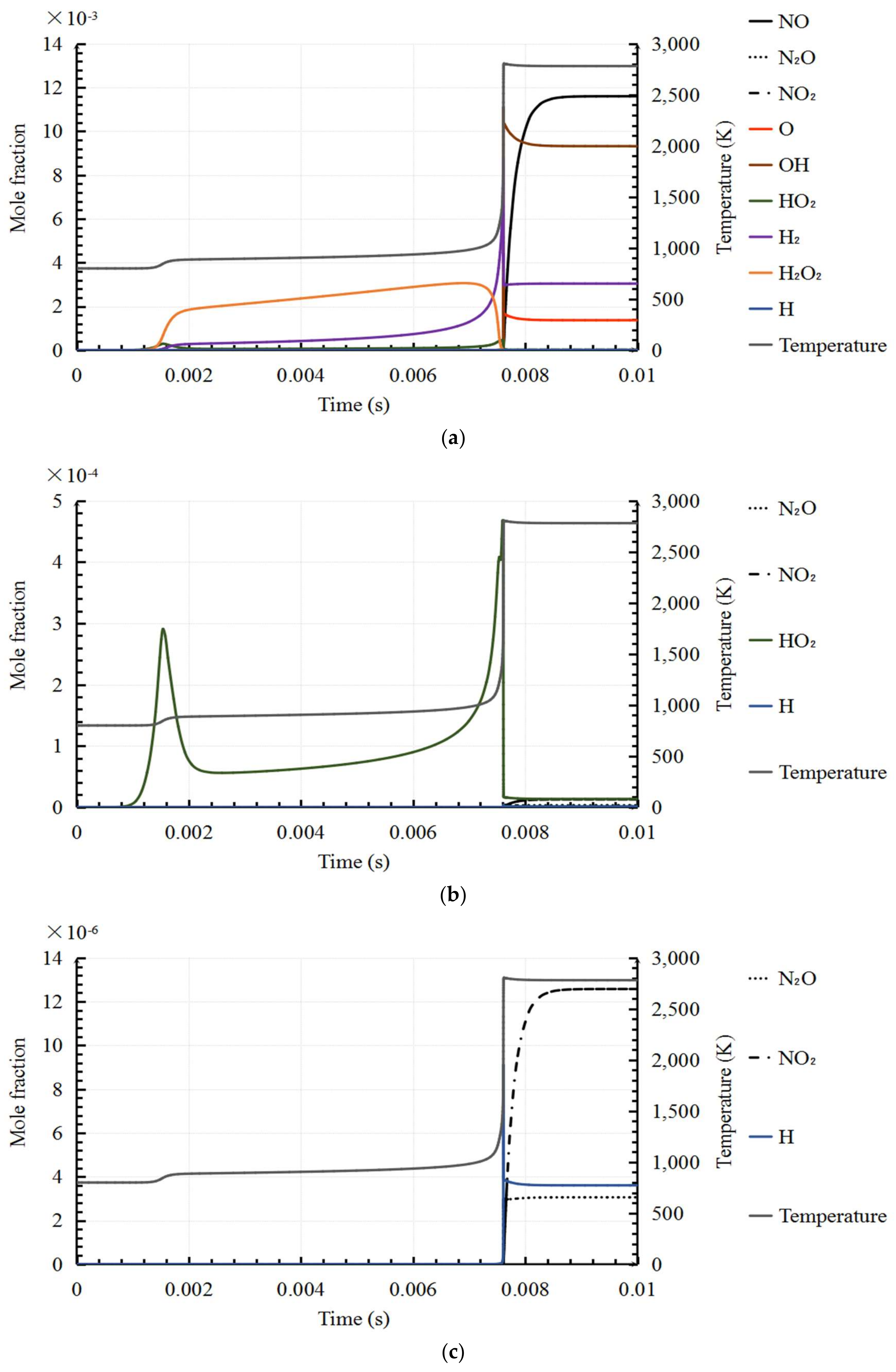
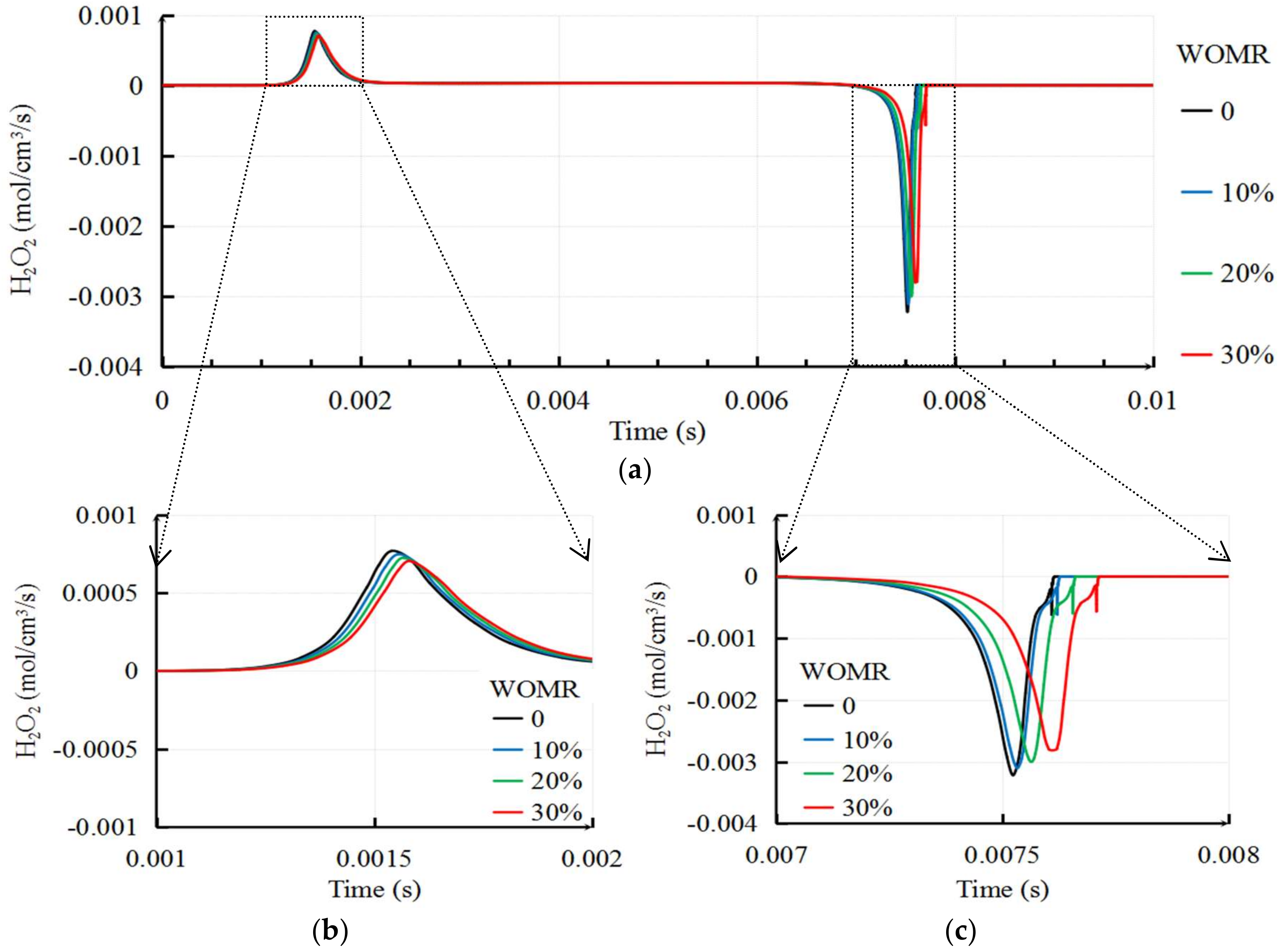
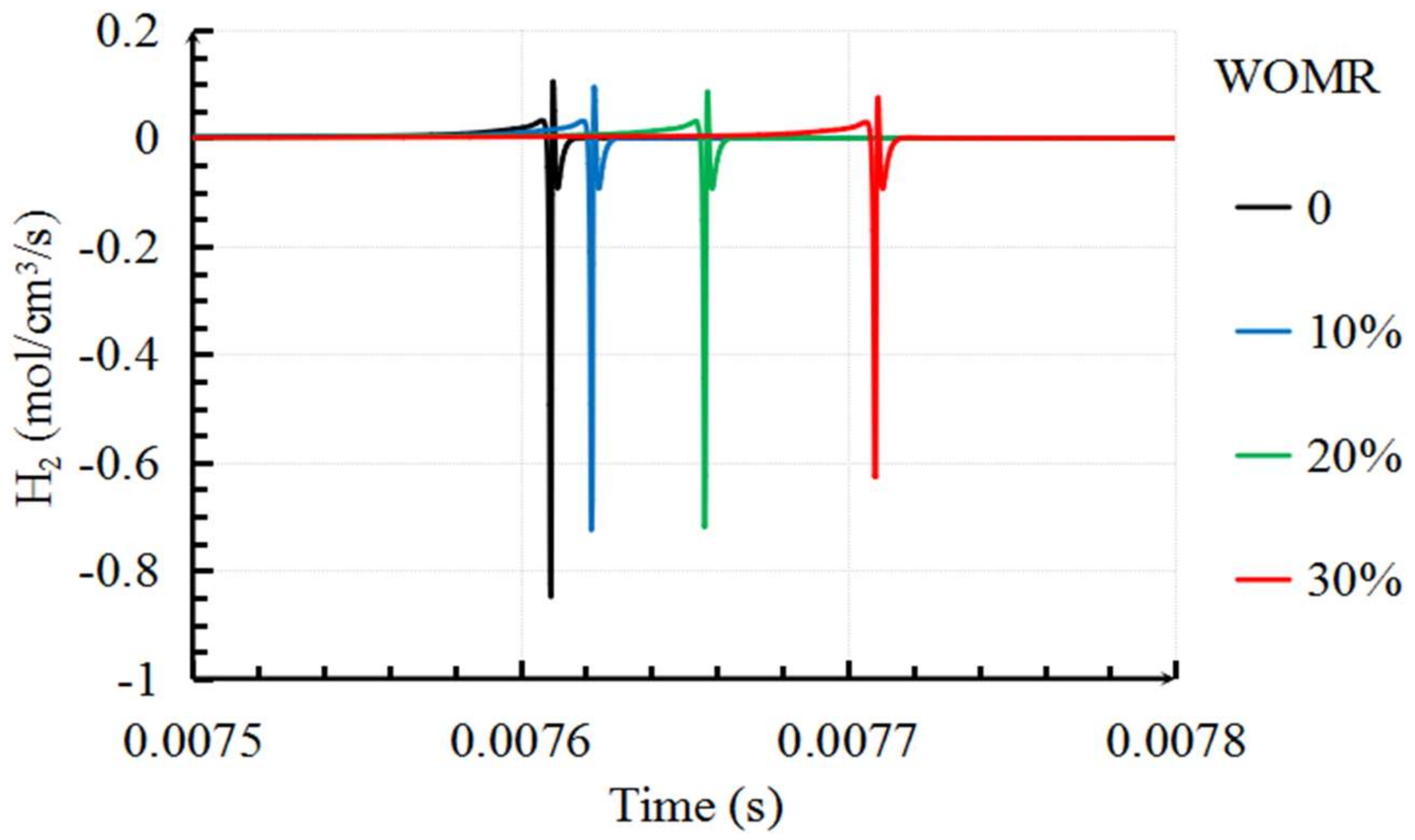
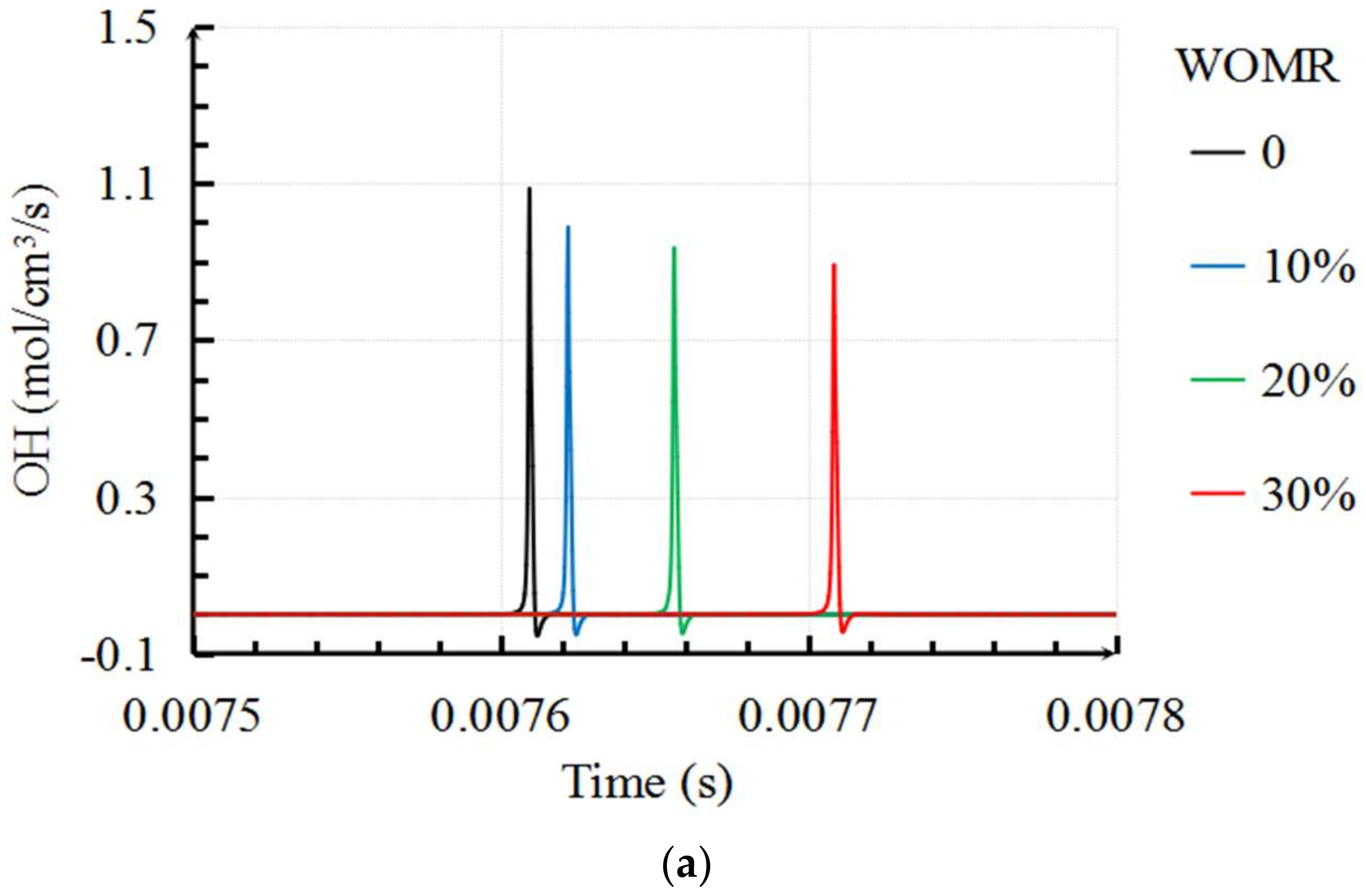

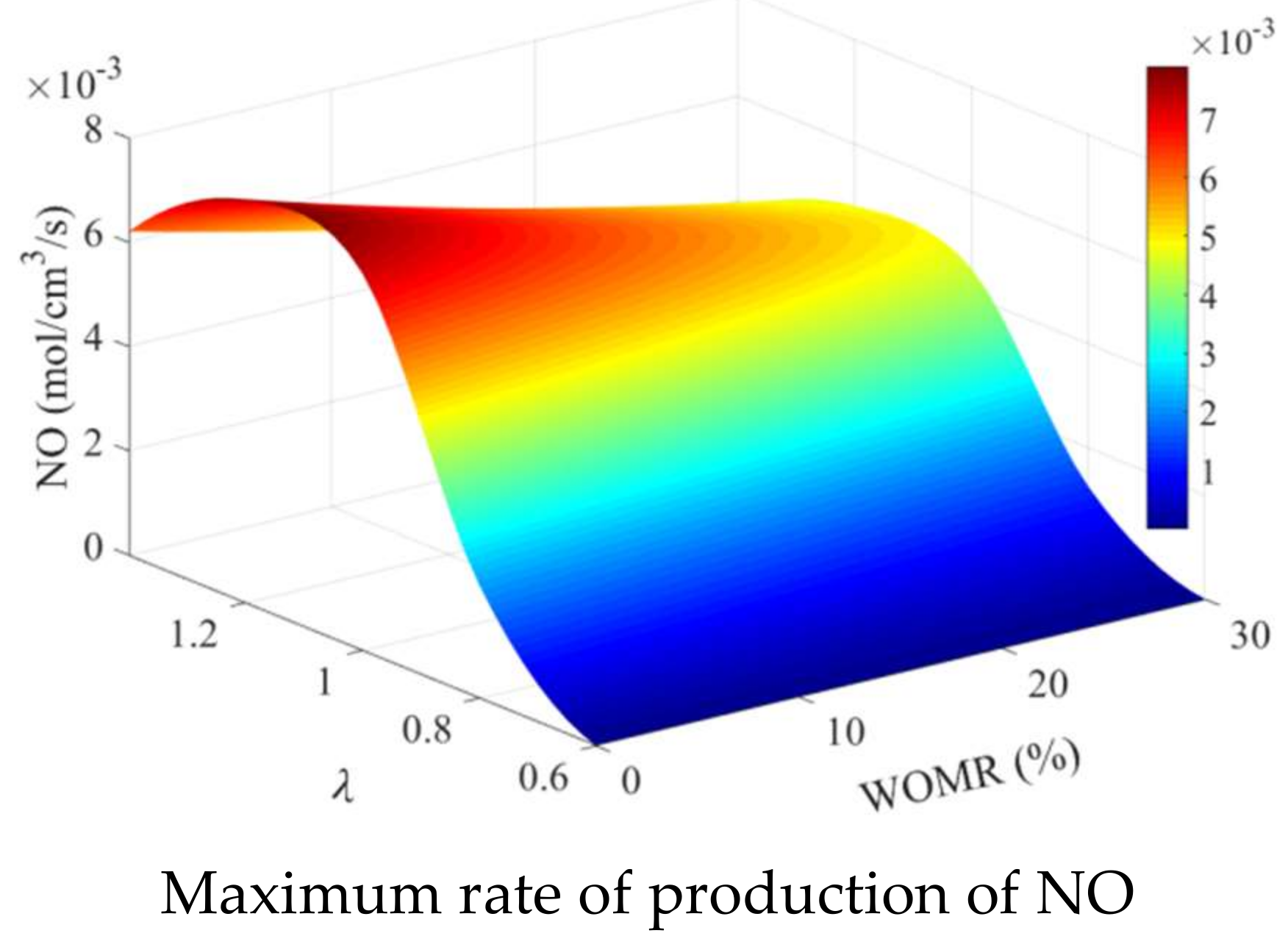
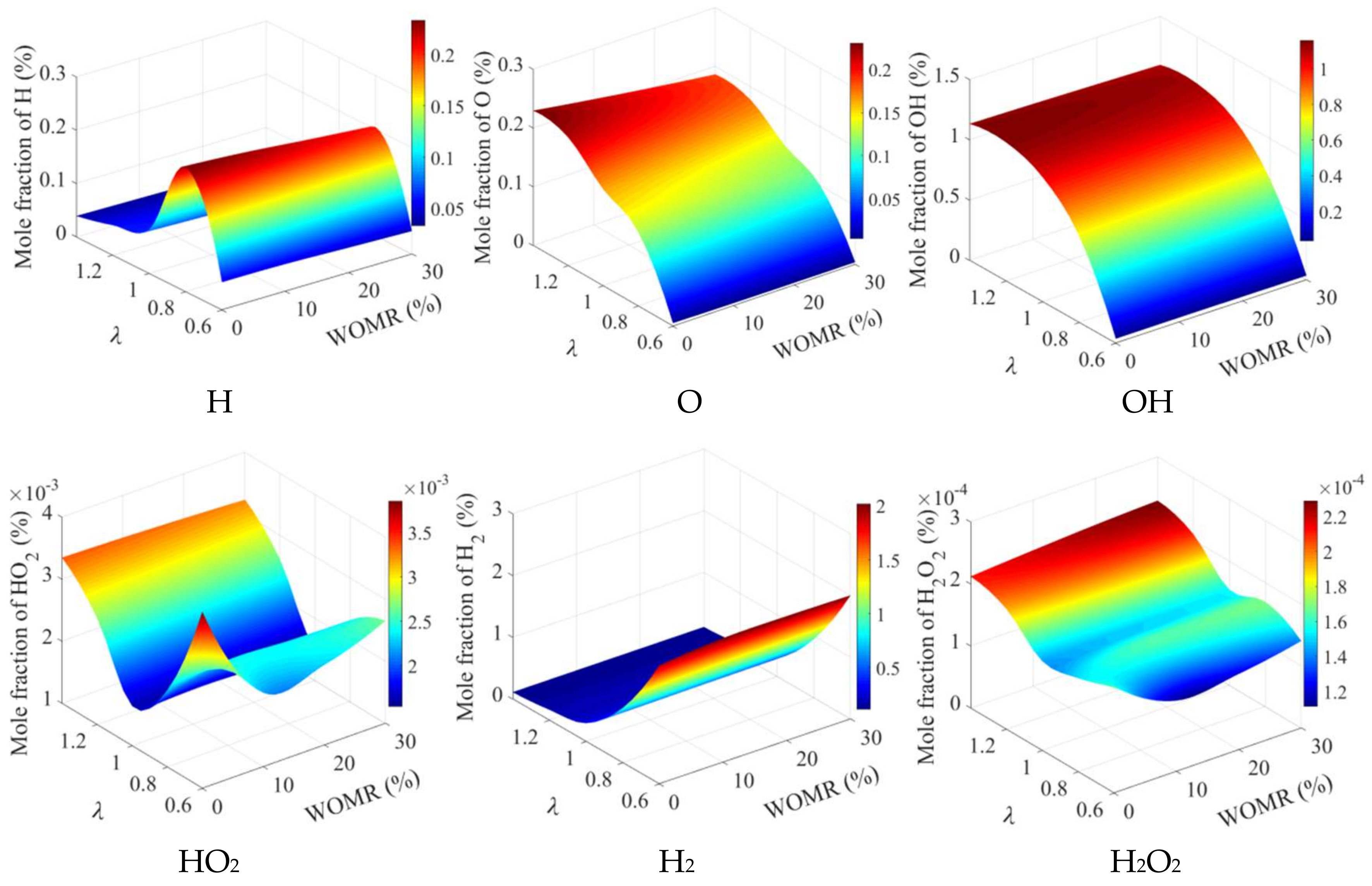


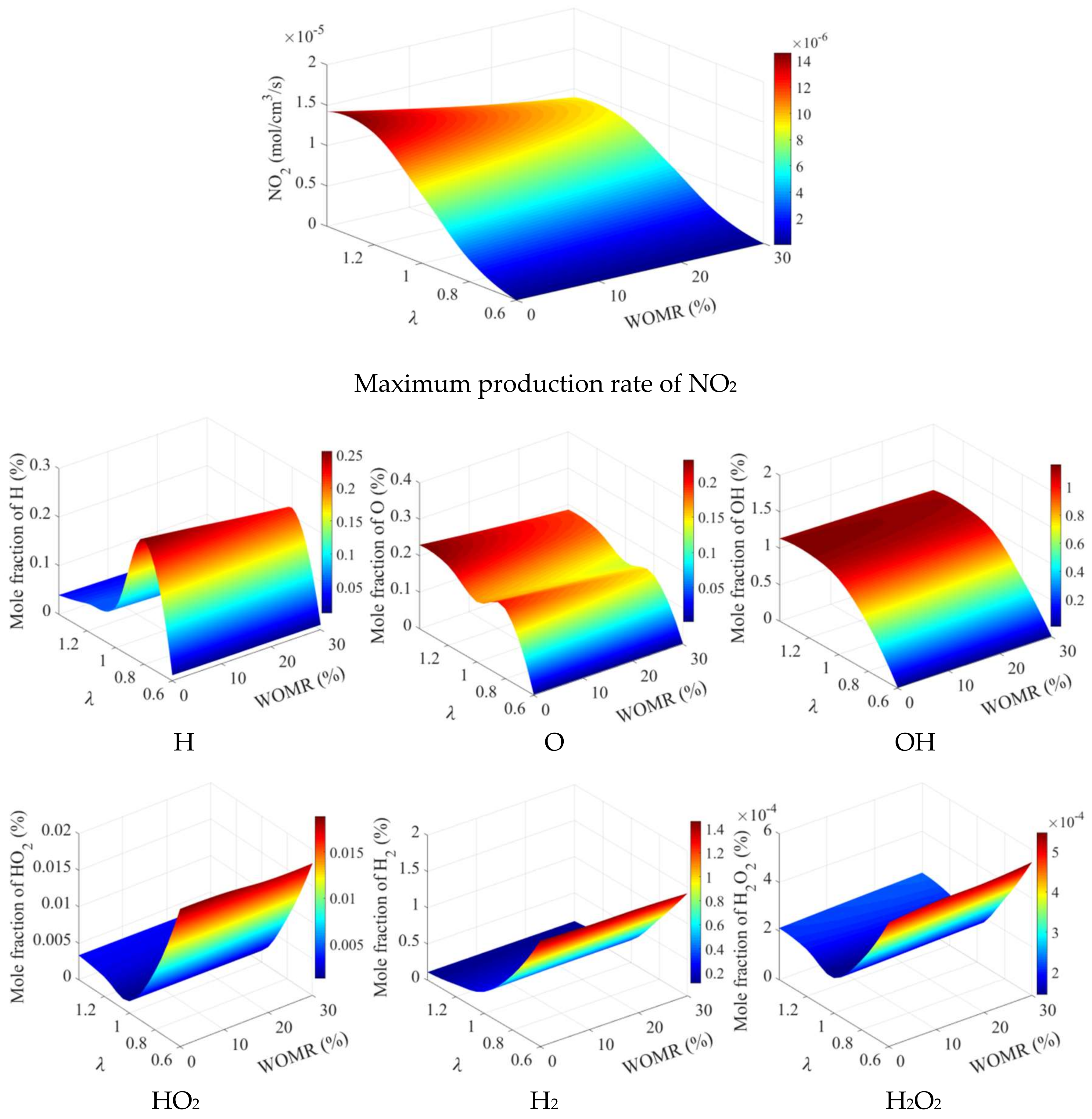

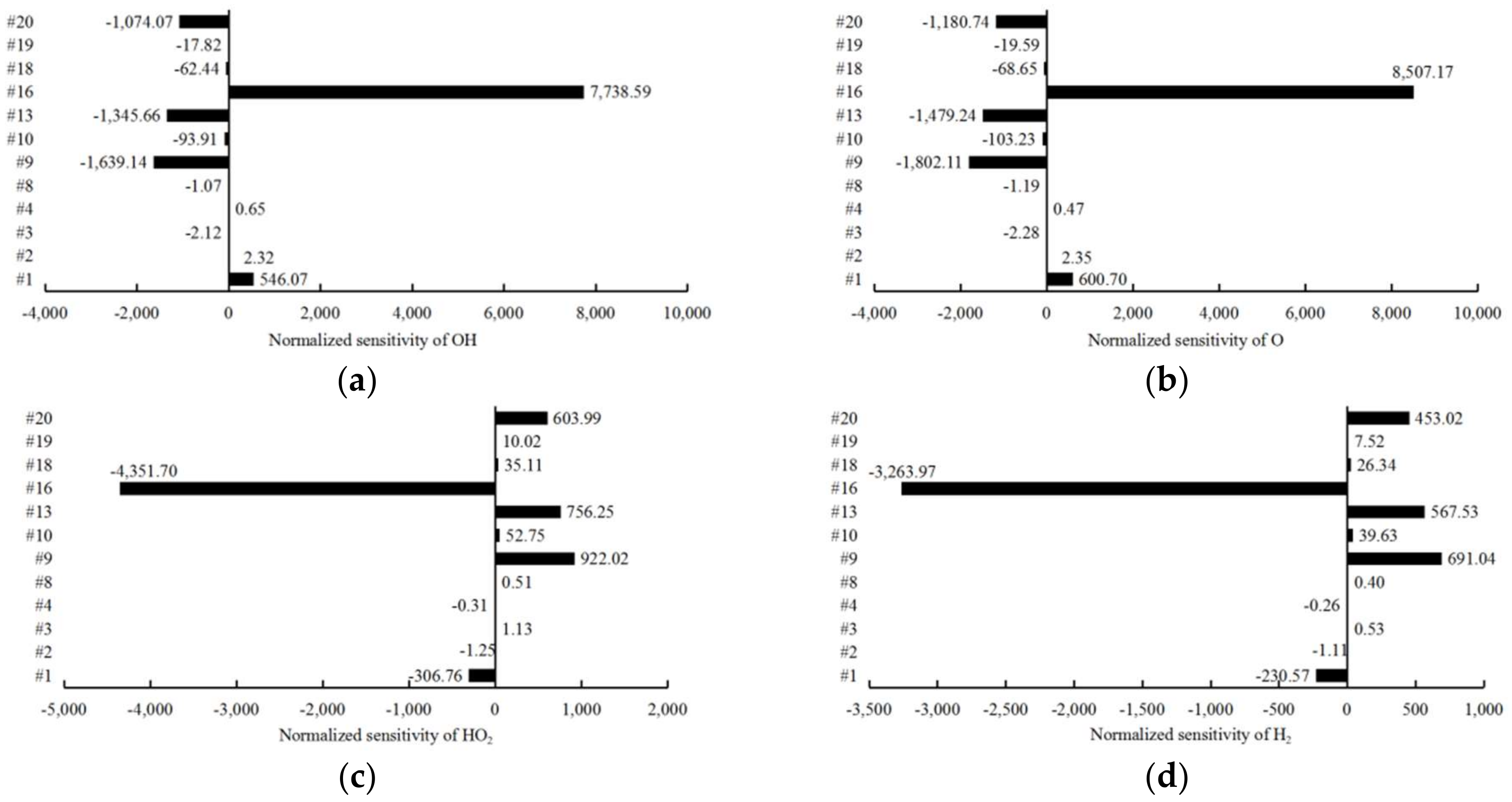
| Category | Value |
|---|---|
| Fuel mixture (mol. %) | C6H5CH3: 37%, iC5H12: 27%, iC8H18: 27%, nC5H12: 5%, nC7H16: 4% |
| Dynamic viscosity (kg·m−1·s−1) | 3.1 × 10−4 (at 25 °C, 1 atm) [29,30] |
| Density (kg·m−3) | 804 (at 25 °C, 1 atm) [29,30] |
| RON | 95.4 [30,31] |
| MON | 87.8 [30,32] |
| Oxidizer mixture (mol. %) | O2: 21%, N2: 78%, Ar: 1% |
| Initial condition | T: 800 K, P: 8 atm, V: 65 cm3 |
| λ | 0.6, 0.8, 1, 1.2, 1.4 |
| Water-oil mass ratio | 0, 10%, 20%, 30% |
| Reaction | Serial Number |
|---|---|
| H + O2 <=> O + OH | 1 |
| O + H2 <=> H + OH | 2 |
| OH + H2 <=> H + H2O | 3 |
| O + H2O <=> 2OH | 4 |
| H2O + M <=> H + OH + M | 8 |
| H + O2(+M) <=> HO2(+M) | 9 |
| HO2 + H <=> H2 + O2 | 10 |
| HO2 + OH <=> H2O + O2 | 13 |
| H2O2(+M) <=> 2OH(+M) | 16 |
| H2O2 + H <=> H2 + HO2 | 18 |
| H2O2 + O <=> OH + HO2 | 19 |
| H2O2 + OH <=> H2O + HO2 | 20 |
| X | H | O | OH | HO2 | H2 | H2O2 | |
|---|---|---|---|---|---|---|---|
| Y | NO | 0.0075 | 0.8586 | 0.8917 | 0.0316 | 0.7789 | 0.3368 |
| N2O | 0.1474 | 0.9940 | 0.8602 | 0.7699 | 0.9383 | 0.0857 | |
| NO2 | 0.0887 | 0.9128 | 0.9789 | −0.5744 | −0.9639 | −0.6662 | |
© 2018 by the authors. Licensee MDPI, Basel, Switzerland. This article is an open access article distributed under the terms and conditions of the Creative Commons Attribution (CC BY) license (http://creativecommons.org/licenses/by/4.0/).
Share and Cite
Yu, X.; He, F.; Du, Y.; Guo, Z. Numerical Studies on the Action Mechanism of Combustion Intermediates and Free Radicals on Nitrogen Oxides under Oil-Water Blended Conditions. Appl. Sci. 2018, 8, 490. https://doi.org/10.3390/app8040490
Yu X, He F, Du Y, Guo Z. Numerical Studies on the Action Mechanism of Combustion Intermediates and Free Radicals on Nitrogen Oxides under Oil-Water Blended Conditions. Applied Sciences. 2018; 8(4):490. https://doi.org/10.3390/app8040490
Chicago/Turabian StyleYu, Xiumin, Fengshuo He, Yaodong Du, and Zezhou Guo. 2018. "Numerical Studies on the Action Mechanism of Combustion Intermediates and Free Radicals on Nitrogen Oxides under Oil-Water Blended Conditions" Applied Sciences 8, no. 4: 490. https://doi.org/10.3390/app8040490
APA StyleYu, X., He, F., Du, Y., & Guo, Z. (2018). Numerical Studies on the Action Mechanism of Combustion Intermediates and Free Radicals on Nitrogen Oxides under Oil-Water Blended Conditions. Applied Sciences, 8(4), 490. https://doi.org/10.3390/app8040490





